- Publisher's Note
- Editorial
- Memories of a Master
- The Gallery as Print Studio
- Printer as Pedagogue
- Perspectives of an Outsider
- Ghosts in the Machines
- Digitalization and Contesting Digitalization
- The Body in Woodcut
- Evoking Symbol and Redefining Space
- The Almanac of Debian Delight
- Permanent State of Suspension
- Perspectives on Survival
- A Look at Printmakers from Australia, Canada and Bangladesh
- Atin Basak: His Artistic Pursuit
- Chor Bazaar, Mumbai
- Didn't We Often Wish We Lived in a Time of Ancient Glory
- The Buddhist Heritage of Pakistan: Art of Gandhara, the Asia Society Museum, New York
- Slivery Facets of Golden Diamonds from Golconda
- Ulysse Nardin: Keepers of History
- Venice Biennale
- What Happened with “Deconstruction India”
- Publication of Graphic Folio by the Members of Society of Contemporary Artists, 2010
- A Blitzkrieg of Creative Impulses
- Let's Paint the Sky Red- A Solo Show of Late Artist Manjit Bawa
- Raghu Rai: Invocation to India - A Variegated Matrix of the Human Predicament
- Rise of Prints
- The Story So Far
- What Happened and What's Forthcoming
- Art Bengaluru
- Art Events Kolkata
- Musings from Chennai
- Mumbai Art Sighting
- Few Printmakers from North East: A Brief Glance at the Contemporary Practices
- Previews
- In the News
ART news & views
Digitalization and Contesting Digitalization
Volume: 4 Issue No: 20 Month: 9 Year: 2011
Musings upon the practice of printmaking in today's digitalized context
by H A Anil Kumar
A graphic print, as it is understood in the general sense within the closely knit graphic art community, is identified as a dearly specialized object, more so within the institutionalized pedagogy of visual arts. A print in itself is held to be an hard-achieved image, necessarily a "hard-copy", 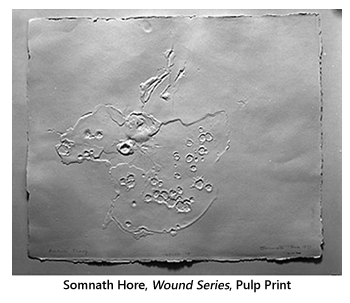 within which the "manual labour" and the "technical precision" that has gone into the making of it (and its multiple versions) is much stressed. [1]
within which the "manual labour" and the "technical precision" that has gone into the making of it (and its multiple versions) is much stressed. [1]
The evidence of the artist as a manual-labourer (even with "hired" labour) is what is primarily visible in any print, no matter what imagery the print contains (upon the dear conventional acid-free printing papers)… until the web-world took over the imagination of the "mechanics" of the reproductive ability of images. Yet printmaking involving manual labour is a diehard practice within the modernist and contemporary institutional premises of visual creative expressions. [2] The dream of the marriage between ideal form and aesthetics beyond "applied consumerism" seems to reside in an abode called as the practice of academic printmaking. [3]
Such an "institutional imagination",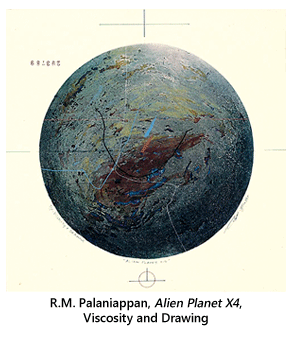 because of the institutionalization of printmaking itself, compulsorily insists that a print is always an image "ahead" of a physical surface (paper). A print is acquired "upon" a flat-bed surface, parallel to the ground; and hung vertical to the gallery ground wherein it seems to be "ahead" of the paper surface in its front. Robert Rauschenberg's concept of "flat-bed" [4] display mode echoes the photocopier, the office tabletops and similar area/surface that is the most consumed space, just a few feet above the ground, in urban 20th century workspaces, both during the industrial as well as the post-industrial era. Somenath Hore's white-in-white Gaping Sliced Wounds series is a set of prints that intervene and further contest the convention of printmaking as an image upon and ahead of a surface upon which it is contained, since the tactile quality of his creation and the surface texture of the media (paper) become indistinguishable.
because of the institutionalization of printmaking itself, compulsorily insists that a print is always an image "ahead" of a physical surface (paper). A print is acquired "upon" a flat-bed surface, parallel to the ground; and hung vertical to the gallery ground wherein it seems to be "ahead" of the paper surface in its front. Robert Rauschenberg's concept of "flat-bed" [4] display mode echoes the photocopier, the office tabletops and similar area/surface that is the most consumed space, just a few feet above the ground, in urban 20th century workspaces, both during the industrial as well as the post-industrial era. Somenath Hore's white-in-white Gaping Sliced Wounds series is a set of prints that intervene and further contest the convention of printmaking as an image upon and ahead of a surface upon which it is contained, since the tactile quality of his creation and the surface texture of the media (paper) become indistinguishable.
The aspects of duality like media-idea, physical-metaphysical, actual-evocative, labour-effect - so much a part of the existing discourse about printmaking is devoid of its twin-hood in 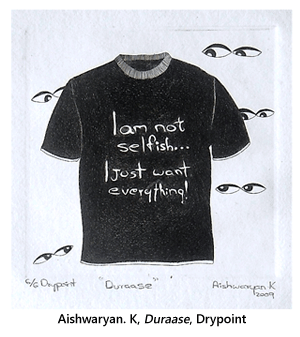 (and because of) Hore's prints while considering it from within the ideal notion of printmaking. In other words, the convention of printmaking whose critique was indistinguishable from its manual production and mechanics was sliced into an ambiguous premise, contesting the very form of printmaking proper. [5]
(and because of) Hore's prints while considering it from within the ideal notion of printmaking. In other words, the convention of printmaking whose critique was indistinguishable from its manual production and mechanics was sliced into an ambiguous premise, contesting the very form of printmaking proper. [5]
A print exists independently though it is complete only when it is compared with its twin-half (a second similar print), within the academic norms. The production of two similar looking prints is an achievement in virtue and a standard for marking its excellence. However, the display culture of the galleries contradicts this by exhibiting singular prints. The academic norm of the conventions of printmaking is deleted, while the product itself is retained through display. Also, the surface quality and the physicality of printmaking are so dearly held on to, as if to curtail its genealogical expansion: the simulative quality of the digital. Jean Baudrillard says that that which can be reproduced (alone) is real. Printmaking is repetition without reproduction.
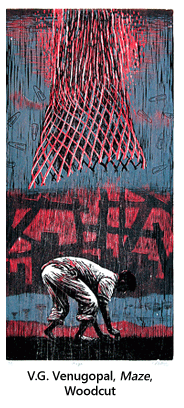 Perhaps the birth of monoprints and the display of the very surface which acted as the motherboard for printmaking (carved wood, etched zinc plate and the like) addresses and problematise the idea of "repetition without reproduction". Many printmakers have shifted over, expanded or have migrated their creative expressions to other media, while those who stayed back have also ventured into the creation of monoprints or have displayed the very surface of these motherboards. Their contestation of the idea of repetition/reproduction/multiplication converts a catalyst-in-itself as the point of focus.
Perhaps the birth of monoprints and the display of the very surface which acted as the motherboard for printmaking (carved wood, etched zinc plate and the like) addresses and problematise the idea of "repetition without reproduction". Many printmakers have shifted over, expanded or have migrated their creative expressions to other media, while those who stayed back have also ventured into the creation of monoprints or have displayed the very surface of these motherboards. Their contestation of the idea of repetition/reproduction/multiplication converts a catalyst-in-itself as the point of focus.
The fact that a print is the result of physical labour is a relative conclusion. It is so because the labour that goes into the making of a graphic print stands as an analogy to the theories that are derived from the new media art. In other words, one speaks about physical nuances while speaking about a print as one does with theories while speaking about new media. From the perspective of printmaking, new media is basically (only) an idea. The seeming proximity between new media (photography and video art, for instance) and printmaking is divided between a mutually indecipherable alienation. Just because of this question of their relation with terms like "labour", "manual", "mechanical", and "digital" reproductions are problematic.
Printmaking today is a practice that has marginalized itself from a Modernist mainstream activity into something that it is very nervous about in the independent Indian art context. There might be artists who have remained,  by commitment or compulsion, within historicized representational forms like painting. Printmaking might be an exception. Instead of claiming that printmakers have been looking out to represent within more lucrative forms, it can be said that many practitioners of printmaking have also been extending their talent into painting, new media and the like, while retaining printmaking as their core form of expression. This could be the story of the history of traditionalized artistic practice in the last two decades of Indian art. [6]
by commitment or compulsion, within historicized representational forms like painting. Printmaking might be an exception. Instead of claiming that printmakers have been looking out to represent within more lucrative forms, it can be said that many practitioners of printmaking have also been extending their talent into painting, new media and the like, while retaining printmaking as their core form of expression. This could be the story of the history of traditionalized artistic practice in the last two decades of Indian art. [6]
The engagement of printmaking with commercial circuits before that and the digitalization of printmaking's relation with digital world after this academicisation, converts the academics of printmaking into the arena of memoirs and mementos in the Indian art context. Sociology can draw a lot of similarity between civilisational Diaspora, migration and these memoirs, memento-isation in the post-independent Indian context. The migration is not from one to another media, as much as it is from one attitude to another. Printmaking in the Indian context, currently, is a cult or a faith, and not for those who don't believe in the specificity of a media in general and graphics in particular.
Speaking from a broader perspective, the cultural theoreticians might find the practice of printmaking as an extravaganza of the apolitical. 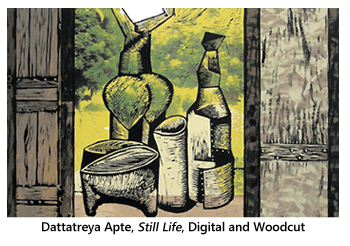 An art historian might pay tribute to the adherence to an academically traditionalized form (of the twentieth century). But both of them, including the printmakers themselves, need to address the issue of 'evolutionist' attitude of the practitioners, in the background of digital art/digitalism and the deliberate distancing of those things from the graphic departments of art schools. Monoprints, catalyst-as-protagonist (rendered surface itself as artwork) are a few practical responses to such digitalization. However, a severe addressal of the notion of 'Walter Benjamin in the age of digital reproduction' is the need of the hour, both from within and without the practicality and euphoria of a "finely rendered" graphic print from the printmaker's atelier[7].
An art historian might pay tribute to the adherence to an academically traditionalized form (of the twentieth century). But both of them, including the printmakers themselves, need to address the issue of 'evolutionist' attitude of the practitioners, in the background of digital art/digitalism and the deliberate distancing of those things from the graphic departments of art schools. Monoprints, catalyst-as-protagonist (rendered surface itself as artwork) are a few practical responses to such digitalization. However, a severe addressal of the notion of 'Walter Benjamin in the age of digital reproduction' is the need of the hour, both from within and without the practicality and euphoria of a "finely rendered" graphic print from the printmaker's atelier[7].
[1] The discourse about the application of printmaking, beyond 'as art', is as 'diverse' (books, illustrations, news media and the like) as there is 'homogeneity' in its production. For instance without the Tebhaga diaries, Somenath Hore's prints might have been appreciated for all those reasons that a non-socio political activist/printmaker's works would be appreciated.
[2] The seven Indian art magazines claiming to cover modernist and contemporary art of India have periodically delved into the issues of printmaking within pedagogic premise, without bridging it with its possible ventures into newer media, post 1990s.
[3] See: Dr.Paula Sen Gupta's article, 'Lasting Impressions' (on Indian printmaking); and 'Surface and Substance' by Anshuman Das Gupta, Art India magazine, volume XI, Issue 1, Jan-March.2006. Both Dr.Paula and Anshuman hint at how the discursive practice of printmaking found pedagogic institutions as safe premises, beyond being consumed as illustrations, propaganda material and the like, much before Indian independence.
[4] Ibid & also Read: Leo Steinberg's 'Other Criteria' for the relation between flatbed concept and the 'youthful (artistic) pranks' of Rauschenberg as well as a summary of the article in 'Art in Theory: 1900-1990'.
[5] Krishna Reddy's viscosity prints (as is evident in his and Hore's wounds series mark the end of the era of printmaking-proper as an academic, mainstream discipline, marking the concluding part of a particular history of form--the form of printmaking. The works of both these artists mockingly render futile the age of digital reproductivity, since the concept of image-upon-surface is inevitably connected what is being conveyed. In other words, the digital avatar of photography cannot dislocate the celebrated premise of the physicality of the convention of printmaking.
[6] Paula Sen Gupta historicizes the arrival of printmaking as an academic activity at Santiniketan (1930s), J.J.School of Art and Baroda (1950s) in her essay, ibid.
[7] Read: 'Walter Benjamin in the Age of Digital Reproduction: Aura in Education: Rereading of 'The Work of Art in the Age of Mechanical Reproduction', Nick Peim, Article first published online: 23rd Jan 2008, The Journal of Philosophy of Education.
Images Courtesy: The Artist